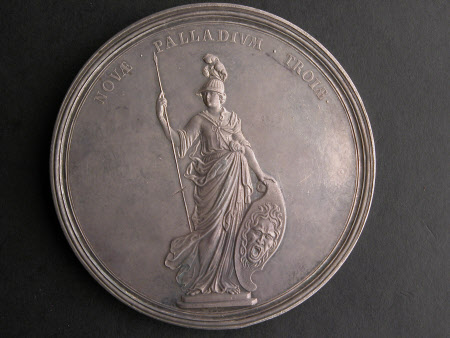The Union of England and Scotland
attributed to John Croker (1670 - 1741)
Category
Coins and medals
Date
1707
Materials
Silver
Measurements
72 mm (Diameter)
Place of origin
Great Britain
Order this imageCollection
Osterley Park and House, London
NT 773297
Summary
Silver, medal commemorating the Union of England and Scotland, attributed to John Croker (1670-1741), struck Great Britain, 1707. A silver medal by John Croker commemorating the union of England and Scotland on 1 May 1707. Obverse with Queen Anne (1665-1714) facing left, wearing crown. Latin legend translates as ‘Anne, by the Grace of God Queen of Great Britain, France and Ireland’. Reverse depicts Anne as Pallas Athena, helmeted and with spear in right hand and in her left a shield bearing the head of the Gorgon Medusa. Legend translates as ’The Palladium of the New Troy.’
Full description
The medal is one of a number issued to celebrate the Act of Union between England and Scotland, which came into effect on 1 May 1707. The reverse depicts Queen Anne as a stately statue of the goddess Athena or Minerva, an allegorical representation of the new nation’s security, with Anne seen as its Palladium or Defence. During the Trojan Wars, the statue of Pallas Athena was regarded as guaranteeing the safety of the city of Troy, so long as it remained safely within its walls. England and Scotland had shared a monarch since the accession of King James I of England and James VI of Scotland in 1603, but the monarchies had remained separate, with both states maintaining their own legislatures. Several attempts were made in the course of the 17th century to unite the two entities, without success. One of the motives for a renewed attempt at union, negotiations for which began in 1705, was the disastrous outcome of the Darien scheme, a Scottish attempt to establish a colony on the Isthmus of Panama for the furtherance of trade with the East. Its failure left its many Scottish investors bankrupted or heavily indebted. The Scots hoped that union would, as indeed it did, create wider opportunities for them both within Great Britain but also in the wider world, in which England had been rapidly becoming an ever-more important player. The English saw the union as bringing political stability after the conflicts of the seventeenth century, notably by removing the risk of separate monarchs in Scotland and England at some future date. From the outset of her reign, achieving the union of her two principal realms had been a key wish of Queen Anne, hence the close emphasis on the monarch in this medal. Although a majority among the Scottish elites supported the notion of union, it was deeply and widely unpopular within the wider Scottish population, sowing the seeds for the renewal of Jacobite hopes. Jeremy Warren 2019
Provenance
Given to the National Trust in 1993 by George Child Villiers, 9th Earl of Jersey (1910-1998).
Marks and inscriptions
Obverse: ANNA. DEI. GRATIA. MAG: BRITAN: FRA: ET. HIB: REGINA. Reverse: NOVÆ. PALLADIVM. TROIÆ.
Makers and roles
attributed to John Croker (1670 - 1741), medallist
References
Cochran-Patrick 1884: Robert William Cochran-Patrick, Medals of Scotland from the earliest period to the present time, Edinburgh 1884, p. 23, no. 1, pl. III.2 Hawkins, E. (ed.) Franks, A.W. and Grueber, H.A: Medallic Illustrations of the History of Great Britain and Ireland to the death of George II, 2 vols,. London, 1885, vol. II, p. 298, no. 115 Eimer 2010: Christopher Eimer, British Commemorative Medals and their Values, London 2010, p. 78, no. 423, Pl. 51

